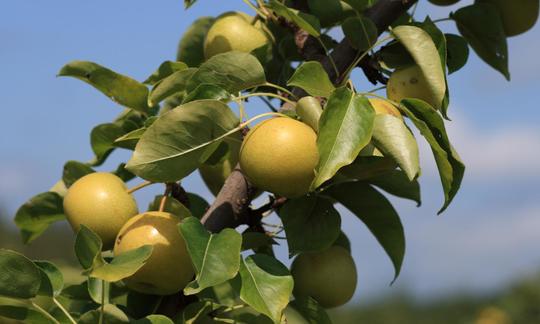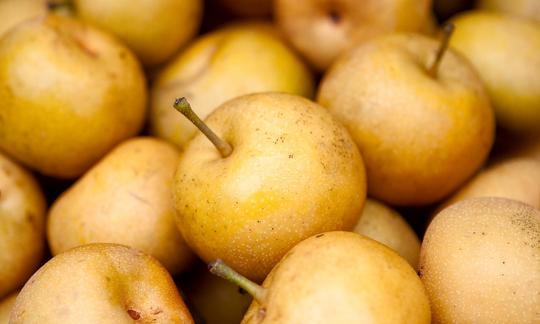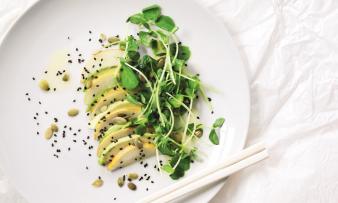Table of contents
The Nashi pear ( Pyrus pyrifolia) is crisp and juicy when raw and has a sweet and sour aroma. Depending on the variety, its taste is sometimes more like that of an apple and sometimes more like that of a European pear. Organic?
Using the Nashi pear in the kitchen:
What is a Nashi pear? The Nashi pear - translated as pear-pear, as Nashi means pear in Japanese - is a spherical to apple-shaped pear with a smooth or slightly rough, pale yellow to ochre-colored skin with small brown speckles. The white, raw flesh is firm, crisp and extremely juicy. The Nashi pear taste is sweet and sour and reminiscent of apple and/or pear. There are many different Nashi pear varieties. The most famous are Kosui, Hosui and Nijisseiki, with the endings indicating the surface structure of the edible skin: varieties with the ending "-seiki" have smooth skins, while varieties ending in "-sui" have a rough surface.
How should you eat the Nashi pear? The Nashi pear is mainly eaten raw and pure like an apple or a pear. It is also very popular in fruit salads and raw vegetable salads - wonderful with spinach, radicchio, pomegranate seeds, pecans in a sweet mustard dressing or with rocket and figs in a pomegranate syrup dressing or with avocados in a ginger-lemon-sesame oil dressing. The raw pear also adds a fresh crunch to a sandwich or poke bowl.
Nashi can also be used to make all kinds of sweet dishes and desserts. You can use it to make compote, fruit puree, jam, marmalade, smoothies and sorbets, use it to make a fine cream or a chocolatey or nutty cake, or dip it in dark chocolate. It also tastes particularly good as a rhubarb -Nashi crumble or poached with a littlevanilla or cinnamon. It is also recommended in breakfast muesli or as dried Nashi slices for a snack.
In terms of taste, pears also go well with salty, hearty dishes. Briefly sautéed or baked in the oven, Nashi pears make a good side dish for autumn dishes or vegetarian and vegan winter dishes. Curries refined with Nashi - e.g. with potatoes and carrots - taste excellent. They can also give soups that certain something, such as Asian noodle soups with lemongrass and ginger, chestnut and Brussels sprout soups or pumpkin soups seasoned with chili. Nashi pears are also often used to make kimchi or as a topping on tarte flambée.
Recipe for vegan red cabbage nashi salad:
Ingredients (for 2 people): 200 g red cabbage, 2 nashi pears (raw, organic), ½ shallot, 1 tbsp apple juice, 2 tbsp rapeseed oil, 1 tbsp apple cider vinegar, 1 tsp maple syrup, 50 g walnuts, some salt,pepper and cinnamon.
Preparation: Finely slice or chop the red cabbage and place in a bowl. Sprinkle with a little salt and massage in well. Rinse the Nashi pears and chop finely with the skin on. Peel and chop the shallot. Add the pears and shallot to the red cabbage and add the apple juice. For the dressing, mix the rapeseed oil, apple cider vinegar and maple syrup together, season with salt and pepper and add cinnamon to taste. Pour the dressing over the red cabbage and Nashi salad (vegan) and distribute the walnuts broken up with your hands over it.
Vegan recipes with Nashi pear (raw) can be found under the note: " Recipes that have the most of this ingredient ".
| Not only vegans or vegetarians should read this: Vegans often eat unhealthily. Avoidable nutritional errors. |
Shopping - where to buy Nashi pears?
The Nashi pear can occasionally be found in a few supermarkets (e.g. Aldi, Lidl, Rewe, Edeka). However, many supermarkets (e.g. Coop, Migros, Denner, Volg, Spar, Hofer) and organic supermarkets (e.g. Alnatura, Denn's Biomarkt) rarely or never offer the Nashi fruit. The pear may be available to buy in Asian shops or at weekly markets.
When purchasing and transporting it home, make sure to place the bulb as high up as possible, as it is very sensitive to pressure.
Found in the wild:
The Nashi pear ( Pyrus pyrifolia) occurs naturally in southern and western China - in the area generally considered to be the center of origin of the Pyrus genus. 1
Storage:
Nashi pears can be stored at room temperature for up to two weeks. They should not be stored in the refrigerator as they could lose their flavour.
Nashi pear: ingredients - nutritional values - calories:
The ingredients and nutritional values of the Nashi pear can be compared with those of the cultivated pear ( Pyrus communis) commonly grown in Europe. What is striking, however, is the slightly higher water content of the Nashi pear (88.2%) compared to the cultivated pear water content (84%). usda Its energy content is 42 kcal per 100 g. The main component of the nutrients is carbohydrates at 11 g/100g - 7 g of which are sugar. 100 g of Nashi pear contains 3.6 g of fiber. There is very little fat (0.23 g/100g) and protein (0.5 g/100g). 2
Nashi pears contain 121 mg of potassium per 100 g (6% of the daily requirement). A similar amount can be found in the 'Granny Smith' apple (120 mg/100g) and in the watermelon (112 mg/100g). The avocado has four times as much potassium at 485 mg/100g. 2
Does the Nashi pear contain vitamins? The vitamin K content is 4.5 µg per 100 g (6% of the daily requirement). This is comparable to that of figs (4.7 µg/100g) and mangos (4.2 µg/100g). Kiwis contain significantly more vitamin K at 40 µg/100g. 2
100 g of Nashi pears also contain 3.8 mg of vitamin C (ascorbic acid) (5% of the daily requirement). Plums (4 mg/100g) and apples (4.6 mg/100g) have similar ascorbic acid contents. Guava is particularly rich in vitamin C with 228 mg/100g . 2
The complete ingredients of Nashi Pear (raw), the coverage of the daily requirement and comparison values with other ingredients can be found in our nutrient tables. In the article Nutrients explained you will get a detailed insight into the topic.
Health aspects - effects:
Is the Nashi pear healthy? Pears ( Pyrus spp.) are generally rich in active substances such as flavonoids and phenolic acids. Various in vitro, in vivo and human studies have pointed to the medicinal effects of pears such as antidiabetic, anti-inflammatory and anti-carcinogenic effects. They also have a protective effect on the respiratory tract and the heart and can help with obesity. 3
More active ingredients can be found in the peel of pears than in the flesh. 3 This also applies to Nashi ( Pyrus pyrifolia), where a 2012 study found larger amounts of phenolic compounds and a stronger antioxidant effect in the peel. 4
Dangers - Intolerances - Side effects:
An allergy to pollen from the Japanese pear can be observed in rare cases. This can trigger seasonal allergic conjunctivitis, especially in farmers. 5
Folk medicine - naturopathy:
In traditional Chinese medicine ( TCM), the Nashi pear is used to treat coughs and bronchial complaints. 6
In Korea, it is considered a traditional remedy for hangovers after alcohol consumption. The results of a 2012 study suggest that pears stimulate enzymes involved in alcohol metabolism and therefore actually contribute to alcohol detoxification. 7
Occurrence - Nashi pear origin:
The Nashi pear ( Pyrus pyrifolia) probably originates from the mountainous regions of western and southwestern China. 8 It is one of the most important fruit tree crops in China, where it is grown on a large scale. There are many local cultivars of the Nashi, which is due to 3,000 years of cultivation and the complex climatic and geographical differences in China. 1 As a result of consumer-oriented selection, a few elite varieties have emerged that are produced on a mass scale. 1,8
In addition to cultivation in China, Japan and Korea, various Nashi varieties are cultivated in Australia, New Zealand, Chile, Italy, France and the USA. 6.9
Growing in the garden:
If you have a sunny garden, you can get a Nashi tree. For more information on growing, read the next chapter "Growing - Harvesting".
Cultivation - Harvest:
The Nashi pear thrives in humus-rich, deep soil with a pH value in the slightly acidic range and in sunny, sheltered locations. 9
The trees are planted in spring. In the first summer they need a lot of water - but they don't like waterlogging. Once the tree has taken root, it only needs to be watered when it is very dry. The root area can be prevented from drying out by covering the tree disc with compost or grass clippings. This also saves you having to fertilize it. In winter it can tolerate temperatures down to -20 °C. 9
Like other pears, the Nashi can be grown as a low-stem tree, a high-stem tree or an espalier tree. The pruning technique for training and maintenance is comparable to that of apples and cultivated pears - however, the rejuvenation of the fruit wood must be done more thoroughly. Since the tree is sensitive to fire blight and cancer, cuts and saw wounds or broken branches should be treated with a wound closure agent. 9
Many Nashi varieties need another Nashi variety that is flowering at the same time for pollination, as they are not self-fertile. Thinning should begin early, as only a few fruit buds should hang per fruit cluster. 9
General information:
Pyrus pyrifolia is a deciduous tree and belongs to the rose family (Rosaceae).
Is the Nashi pear a cross between an apple and a pear? Although the Nashi pear looks like an apple and has alternative names such as apple pear, bapfel and birpfel, it is not a cross between an apple and a cultivated pear, but is a pear of its own. There are several varieties of the Nashi pear, including the Benita variety, which is a cross between the cultivated pear Général Leclerc and the Nashi pear Hosui.
Alternative names:
The Nashi pear, Nashi pear or Nashi has many synonyms. Some of these are: Sand pear, Japanese pear, Korean pear, Asian pear, Chinese pear, Kumoi, apple pear, Bapfel and Birpfel. Incorrect spellings (eg pear Nashi, Naschi pear, Naschi pear, Naschi fruit, Naschi fruit, China pear, Nachi pear, Nasi pear, Naschbirne, Nashi Bitne, Nasho pear, Naschis) creep in.
In English they are called Asian pear, Japanese pear, Chinese pear, Korean pear, Singo pear, Taiwanese pear, apple pear, sand pear, zodiac pear, three-halves pear, papple and naspati.
Keywords for use:
In Japan, it is believed that Nashi pears ward off bad luck. The large trees were often planted in front of the house gates or in the corners of the property as symbolic protection for the family. 10
Beautiful specimens are also often used as gifts for family and friends. Traditionally, the fruit is given as a gift during the autumn season. This underlines the Japanese belief that one should eat with the seasons in order to maintain a balanced, healthy mind. 10
Literature - Sources:
Bibliography - 10 Sources
| 1. | Jiang Z, Tang F, Huang H, Hu H, Chen Q. Assessment of genetic diversity of chinese sand pear landraces (Pyrus pyrifolia Nakai) using simple sequence repeat markers. HortScience. 2009;44(3):619–26. |
| 2. | USDA United States Department of Agriculture. |
| 3. | Hong S-Y, Lansky E, Kang S-S, Yang M. A review of pears (Pyrus spp.), ancient functional food for modern times. BMC Complement Med Ther. 2021;21:219. |
| 4. | Ma J-N, Wang S-L, Zhang K, Wu Z-G, Hattori M, Chen G-L, u. a. Chemical components and antioxidant activity of the peels of commercial apple-shaped pear (Fruit of pyrus pyrifolia cv. Pingguoli). J Food Sci. 2012;77(10):C1097-1102. |
| 5. | Yanagisawa S, Nagaki Y, Hiraki S, Kadoi C, Hayasaka S, Teranishi H. Seasonal allergic conjunctivitis induced by Japanese pear pollen. Jpn J Ophthalmol. 1999;43(3):240–2. |
| 6. | Foodprint.org Asian Pears. |
| 7. | Lee H-S, Isse T, Kawamoto T, Woo H-S, Kim AK, Park JY, u. a. Effects and action mechanisms of Korean pear (Pyrus pyrifolia cv. Shingo) on alcohol detoxification. Phytother Res. 2012;26(11):1753–8. |
| 8. | Xue L, Liu Q, Hu H, Song Y, Fan J, Bai B, u. a. The southwestern origin and eastward dispersal of pear (Pyrus pyrifolia) in East Asia revealed by comprehensive genetic structure analysis with SSR markers. Tree Genetics & Genomes. 2018;14(4):48. |
| 9. | Pflanzen-lexikon.com Nashi-Birne (Pyrus pyrifolia). |
| 10. | Specialtyproduce Asian Pears. |











Comments